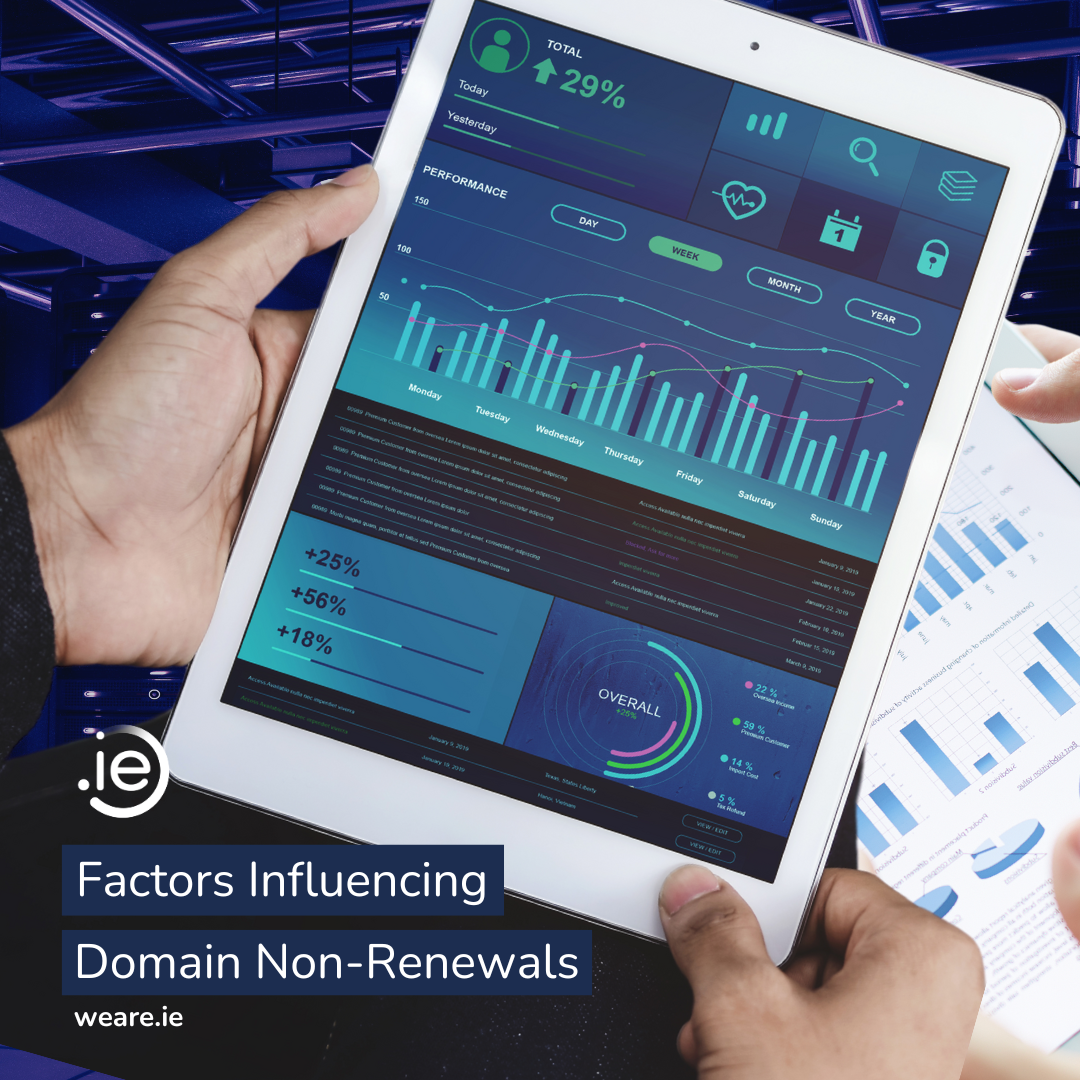Blog | Factors Influencing Domain Non-Renewals
Introduction
According to statistics from CENTR, the umbrella organisation for European TLDs, domain renewal rates are trending downward across a lot of its members. This is a very concerning situation with many implications.
Within .ie, we have been working hard to find explanations for the shrinking renewal rates and identify potential data-driven interventions that will reverse the trend.
Our first approach was to create a predictive model that, when fed information about an upcoming domain renewal, will tell us whether it’s likely to be completed successfully or not.
You can read about this work in Priya’s most recent blog post “The Renewal Prediction Playbook”
This blog summarises our presentation to our CENTR colleagues in June. Using conditional probabilities, we identified domain attributes that are more likely to influence the outcome of the renewal process.

Objectives
Our goals with this work were the following:
-
Quickly and simply identify domain attributes affecting the outcome of the renewal process.
-
Build interventions to change the outcome, based on the most influential attributes, by collaborating with registrars on a data-driven approach.
-
Analyze if the interventions changed the outcome for the better, this is, increase the renewal rate.
This write-up will focus on the first point, in detail.
Methodology and Data
“If I have seen further, it is by standing on the shoulders of giants”, a well-known phrase used by Sir Isaac Newton, to explain you reach a greater understanding by benefiting from previous work. This analysis, presentation and blog post are inspired by the article “Domain Retention Insights for nz ccTLD” by Sherry Liu, whom I had the privilege to work with for a couple of years while living in New Zealand.
For meaningful results, we use a year’s worth of renewals, by analysing the list of domains expected to renew between November 2022 and October 2023, totaling 292,410 domains, out of which 50,132 were not renewed, an 83% renewal rate.
Combining the renewal process outcome with registration information, details gathered by our own web crawler and DNS activity, a broad scope of attributes was built. Let’s explain what we used.
From Registration information:
-
Type of registrant: Company, Charity, Other
-
Domain Age
-
Number of characters in the domain
-
Registration Season, according to the Northern Hemisphere
-
Registration Quarter
-
Was the original registration on a weekday or a weekend
-
Does the domain have four digits representing a year?
-
Number of previous renewals
-
an Internal Registrar categorisation
-
Registrar business type according to CENTR
-
Flag if the domain is part of a portfolio of domains held by the same registrant
-
By looking into the postal address of the registrant
-
Continent of registration, based on the registrant country
-
a flag to indicate if the registrant is based in the Republic of Ireland
-
A flag indicating if the registrant is based in Dublin, as a large portion of registrations originate there.
-
-
If the domain was transferred between Registrars before Renewal
-
By analyzing the keywords in the domain, we add
-
A flag indicating if there is an English verb
-
A flag indicating if there is a noun
-
A flag indicating if there are numbers
-
From our own Web Crawler
-
Is there a working website for the domain?
-
If it has a working website, is it a parked page or a functioning website. This is a categorisation defined by CENTR, called Low Content Taxonomy.
-
Is the website redirected to another website?
-
Is the unsecured version of the website automatically redirected to the secure version when visited?
-
SSL status of the website
-
Is the website content managed using a CMS (Content Management System)
-
Does the website have e-commerce capabilities
From our DNS testing:
-
A flag indicating if the domain uses:
-
CAA, for certificate security
-
DMARC, for email security
-
SPF, for email security
-
DKIM, for email security
-
-
Does the domain have one or more MX records
From our DNS infrastructure, we measure how much DNS activity a domain receives, and calculate their DNS Magnitude, based on an idea popularized by NIC.AT
Our research question is: If a domain has X attribute, how does it affect its likelihood of renewal?
Using conditional probabilities and odds ratio, we can identify those attributes. Let’s explain using an example:
Starting from an 83% renewal rate, and a 17% deletion rate, let’s look if a domain created during the weekend, a potential impulsive registration, affects their renewal outcome.
Conditional probabilities are applied when prior information or conditions affect the likelihood of an outcome. In this case, we are seeking the probability of renewal of a domain given it was created on a week day.
The probability of a domain being created on a weekday is 93.9%, and within those, the probability of renewal is 77.9%, producing a conditional probability of 83% (77.9% / 93.9%). If we repeat the same exercise for domains created on a weekend, and then renewed, we obtain a conditional probability of 82%.
Here we use the odds ratio to conclude if this created on a weekday/weekend is a relevant attribute to explain renewal. The odds ratio is used in the area of medicine, to explain if a treatment or exposure affects a health outcome. If the odds ratio is greater than 1, it’s a strong positive association, if the odds ratio is lesser than 1, it’s a strong negative association, and if it’s 1, there is no association.

Recalling the calculations:
-
The conditional probability of the renewal of a domain created during a weekday is 83%
-
The conditional probability of the renewal of a domain created during the weekend is 82%
-
The odds ratio is 1.01, indicating no influence.
With the odds ratio in our tool belt, we can look into the domain attributes at hand and identify which ones affect renewals the most.
Single attribute influencing renewals
We find the attributes with the highest odd ratios in favour of renewal.
-
If the Registrar is in the IT Infrastructure business, the domain is 45 times more likely to renew
-
When the Registrant is a Charity, it’s 37 times more likely to renew. This is expected as charities don’t have to pay for their domains.
-
If the Registrar is in the Brand Protection business, it’s 27 times more likely to renew.
-
If the registrant is based in Western Europe, 25 times more likely, and if it’s in Northern America, 23 times more likely to renew
-
If the domain was transferred between registrars before renewal, 24 times more likely to renew.
-
If the domain has high levels of usage as represented by DNS magnitude, the odds ratio is 17 in favour of renewal. In this case, a magnitude of 4 or more.
-
If the domain is 10 years or older, also shows a 17:1 ratio for renewal.
Above are the top 7 factors, there are others with a lower odds ratio that still positively affect renewal, like web usage, a domain with a working site is ten times more likely to renew, the same as a domain with a website with CMS and e-commerce capabilities.
Single attribute influencing non-renewal
Let’s look now at what the odds are against a renewal.
Out of the 33 attributes inspected, reaching 129 attribute/value pairs, none of them produced an odds ratio higher than 1. This means there are no identifiable attributes explaining non-renewals, we only have attributes influencing renewals. This is expected, as we worked in the predictive model for months and none of the attributes we used helped to discriminate renewals and non-renewals.
Bonus track: pair of attributes influencing renewals and non-renewals
If we do a quick look beyond single attributes and cover pairs of attributes, we can say:
-
Domains younger than 1 year that return a blocked page when visited, are 2.6 times more likely to go into non-renewal
-
Domains with a working website registered via a Registrar in the IT Infrastructure business are 93 times more likely to renew.
-
Domains without a website created during Quarter 4 of any year, are 1.8 times more likely to fail to renew
-
When the registrant is from North America and it’s been in our system for more than 7 years, it’s 80 times more likely to renew
For these findings, we filtered out combinations with less than 10 domains renewed or deleted, to make it statistically significant.
Conclusions and next steps
No one wants to write about failed experiments or analyses. This work intended to find domain attributes affecting non-renewals to create interventions, but we found the opposite.
We identified the type of Registrar, the location of the Registrant, how much a domain is used and its age greatly influence the likelihood of renewal.
We can now encourage our Registrars to protect the domains showing positive signs for renewal, while the team continues to work on unearthing potential domain attributes that could explain non-renewals.
There will be a third blog post explaining the building and testing of a predictive model for renewals, stay tuned!
Access all our blogs here

As the trusted national registry for over 330,000 domain names, .ie protects Ireland’s unique online identity and empowers people, communities and businesses connected with Ireland to thrive and prosper online. A positive driving force in Ireland’s digital economy, .ie serves as a profit for good organisation with a mission to elevate Ireland’s digital identity by providing the Irish online community with a trusted, resilient and accessible .ie internet domain. Working with strategic partners, .ie promotes and invests in digital adoption and advocacy initiatives – including the .ie Digital Town Blueprint and Awards for local towns, communities and SMEs. We provide data analytics and dashboards built by the .ie Xavier team to help with data-led decision-making for the public, registrars and policymakers. The organisation is designated as an Operator of Essential Services (OES) under the EU Cyber directive, and we fulfil a pivotal role in maintaining the security and reliability of part of Ireland’s digital infrastructure.